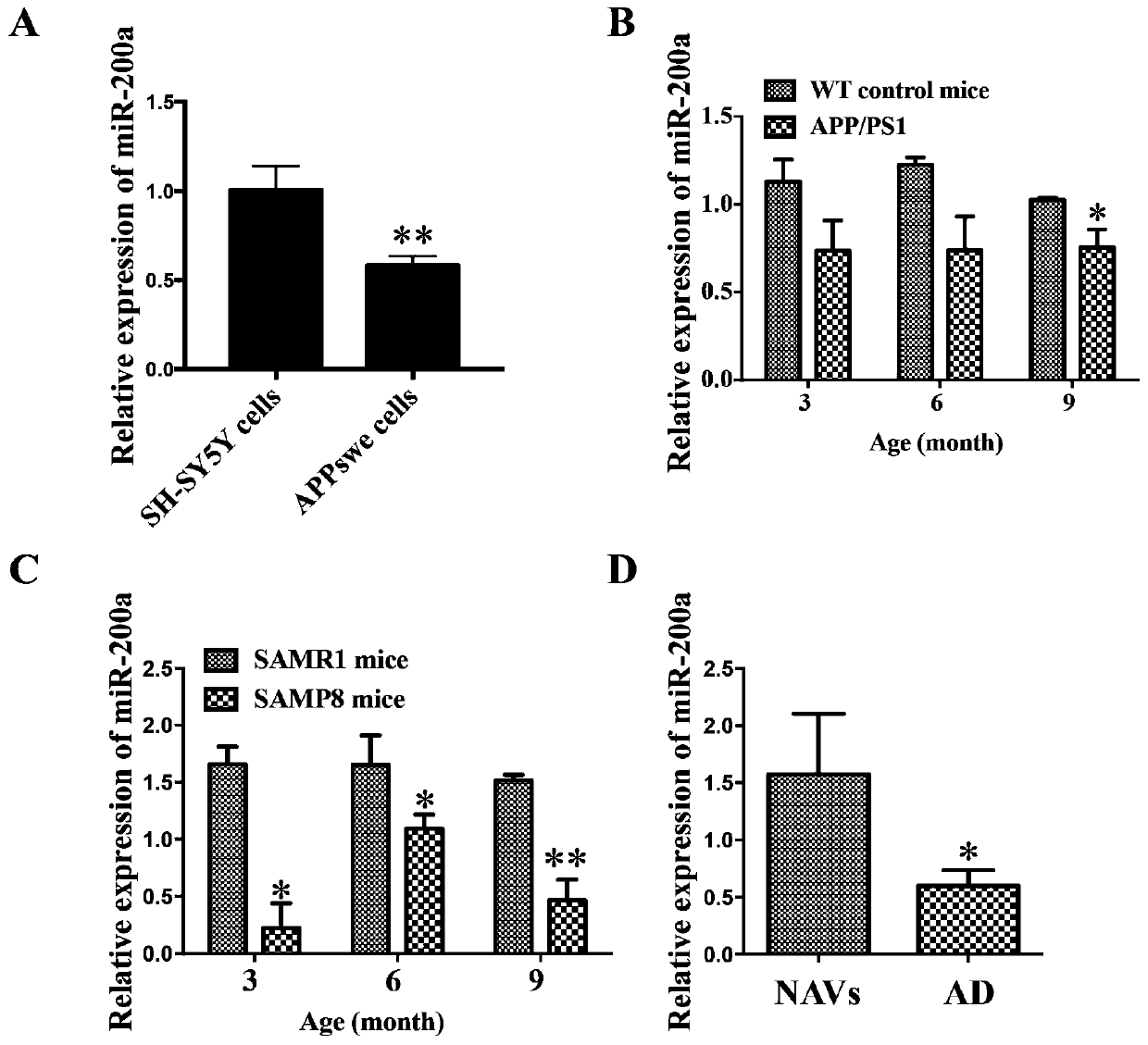Application of miRNA 200 cluster as marker for diagnosing and/or treating Alzheimer's disease
A technology for Alzheimer's disease, hsa-mir-200a, applied in the determination/testing of microorganisms, medical preparations containing active ingredients, drug combinations, etc., can solve the problem of lack of early screening methods, ineffective AD, complex pathogenesis
- Summary
- Abstract
- Description
- Claims
- Application Information
AI Technical Summary
Problems solved by technology
Method used
Image
Examples
Embodiment 1
[0040] Example 1. miRNA chip technology detects differential expression of miR-200a in brain tissue of AD model animals and wild-type animals
[0041] Select 1, 3, 6 and 9-month-old APP / PS1 double transgenic mice respectively, extract mouse brain tissue RNA and perform Hy3TM and Hy5TM fluorescent labeling on miRNA, the microRNA of the miRNA 200a cluster of the present invention is hsa-miR-200a , whose sequence is shown in SEQ ID NO.1: ccgggccccu gugagcaucu uaccggacag ugcuggauuu cccagcuugacucuaacacugucugguaac gauguucaaa ggugacccgc. Its default mature body (hsa-miR-200a-3p) sequence is shown in SEQ ID NO.2: uaacacuguc uggguaacgau gu. Among them, mature (hsa-miR-200a-3p) miRNA reverse transcription primer: SEQ ID NO.3: gtcgtatcca gtgcagggtc cgaggtattc gcactggatacgacacatcg; quantitative PCR (qPCR) forward primer: SEQ ID NO.4: gcgcgtaaca ctgtctggta a; reverse Primer: SEQ ID NO. 5: agtgcagggt ccgaggtatt. Then the sample was hybridized with miRCURYTM Array chip, the chip was scanne...
Embodiment 2
[0042] Example 2, expression changes of miR-200a in AD model cells
[0043] The Swedish-type mutant APP gene was stably transfected into SH-SY5Y cells to construct a stably transfected APPswe cell line. Under the stimulation of copper ions, APPswe cells will generate a large amount of Aβ, resulting in apoptosis, which is one of the commonly used cell models of AD. In the present invention, 300 μM copper ions are used to damage APPswe cells to establish an AD cell model, and cell RNA is extracted to detect the expression level of miR-200a. Such as figure 2 As shown in middle A, compared with normal control SH-SY5Y cells, the expression of miR-200a in APPswe cells was significantly down-regulated (mean±SEM, n=3, **P<0.01), and miR-200a was related to Aβ damage.
Embodiment 3
[0044] Example 3, the expression changes of miR-200a in AD model animals and natural aging animals
[0045] APP / PS1 mice are commonly used AD transgenic mouse models, and SAMP8 mice are natural aging mice, which are often used in aging-related research to detect the changing characteristics and related mechanisms of degenerative diseases. APP / PS1 double transgenic mice aged 3, 6, and 9 months and their wild-type (WT) control mice (purchased from the Model Animal Research Institute of Nanjing University), as well as SAMP8 mice and their control mice (SAMR1) ( The hippocampal tissue RNA provided by the Institute of Genetics and Developmental Biology, Chinese Academy of Sciences was used to detect the expression of miR-200a by qPCR. Such as figure 2 As shown in middle B, the expression of miR-200a in the hippocampus of 3, 6, and 9-month-old APP / PS1 mice showed a downward trend, and there was a significant difference between 9-month-old and WT mice of the same age ( mean±SEM, n...
PUM
 Login to View More
Login to View More Abstract
Description
Claims
Application Information
 Login to View More
Login to View More - R&D
- Intellectual Property
- Life Sciences
- Materials
- Tech Scout
- Unparalleled Data Quality
- Higher Quality Content
- 60% Fewer Hallucinations
Browse by: Latest US Patents, China's latest patents, Technical Efficacy Thesaurus, Application Domain, Technology Topic, Popular Technical Reports.
© 2025 PatSnap. All rights reserved.Legal|Privacy policy|Modern Slavery Act Transparency Statement|Sitemap|About US| Contact US: help@patsnap.com



